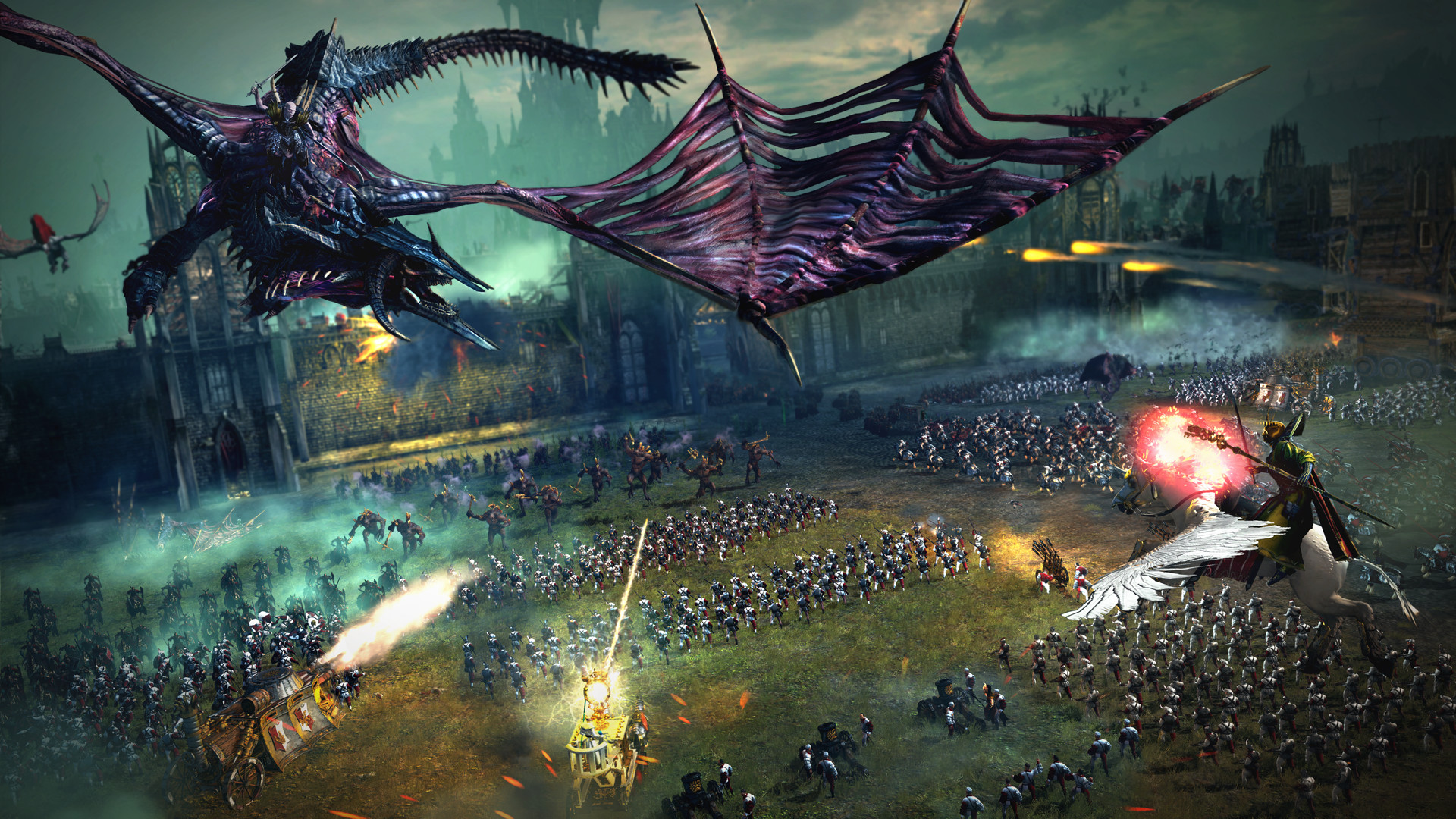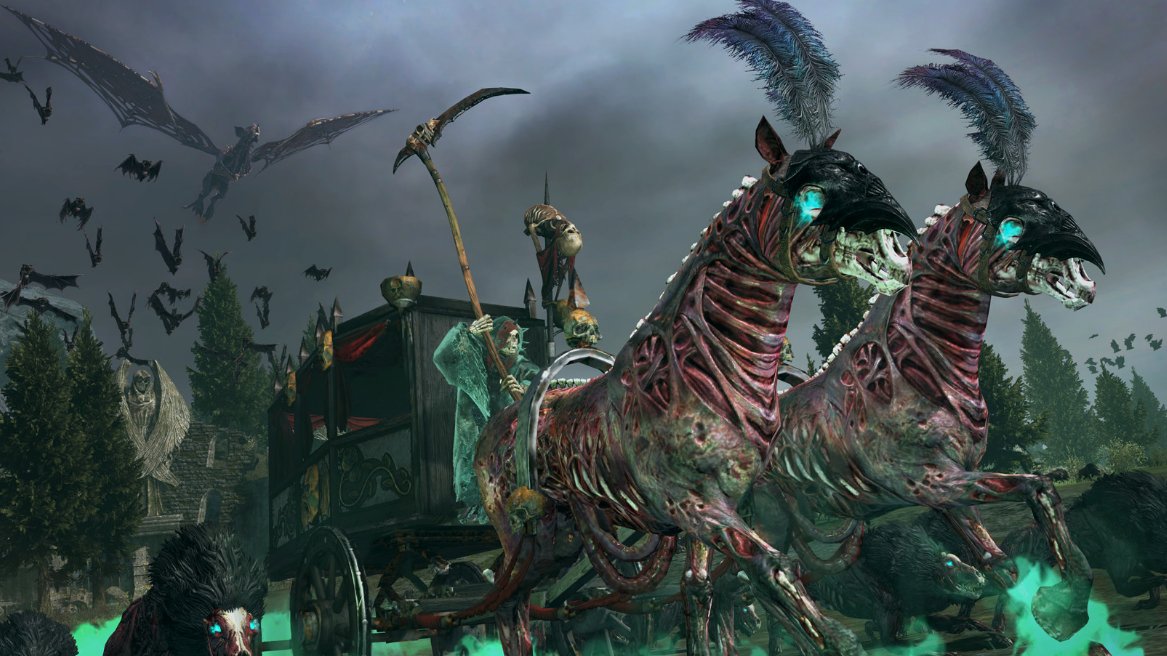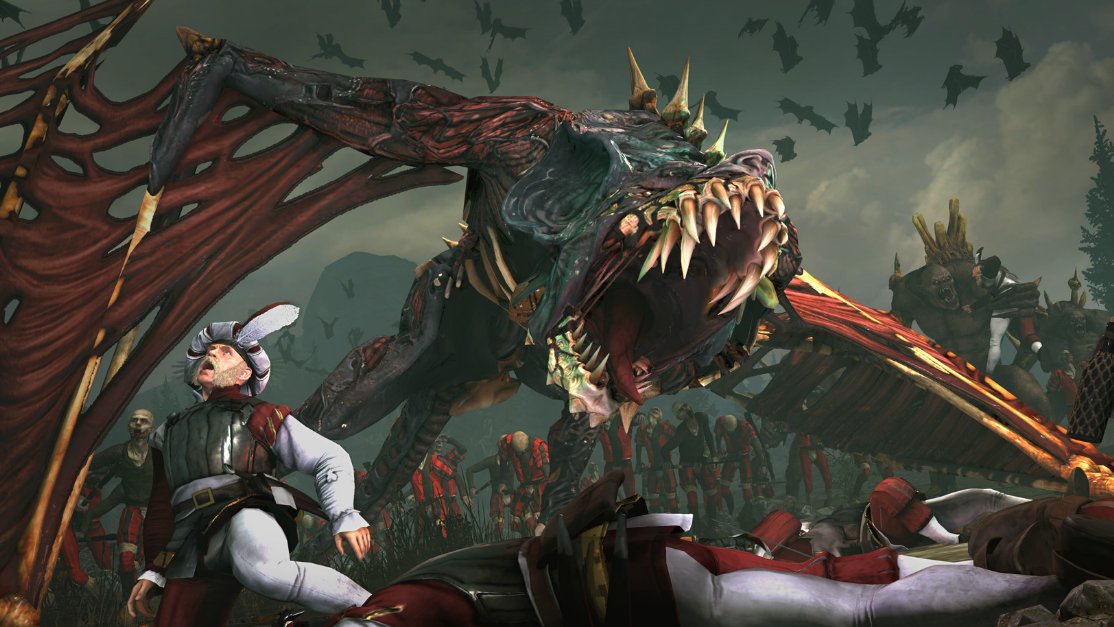Total War: Warhammer Vampire Counts guide
How to make the Empire’s baddest blood-drinkers not suck.

The vampires are the most unusual of the starting factions in Total War: Warhammer. On the battlefield and off, their living dead have an array of special rules which make them unusually hard to beat. Their basic troops never run away and can act as tarpits for much more powerful units—but they have no ranged units whatsoever. What they do have is an array of flying units, magic and powerful heroes to lay waste to the enemy.
They also have a relatively safe starting position, in a corner of the Empire, backed up against The World’s Edge Mountains. Sure, like every Warhammer faction, they’re surrounded by enemies. And, sure those enemies see them as abominations that should be wiped off the face of the earth. But pacifying moves on the part of the vamps can neutralise that problem.
Particularly, the Dwarfs should be no trouble in the early game, as the Greenskin hordes advance on them. You’ve no reason to even attack the Dwarfs, because you can’t take their lands. Your only real targets are the human lands—The Empire, Kislev, The Border Princes and Bretonnia if you can reach it. And you need to keep a weather eye on the North, because you’re located very close to where Chaos starts.
Sylvanian families
Sylvania is backed up into the mountains, so its East side is mostly secure. It’s divided into two provinces, of which you only own one region at the start. However, once you’ve conquered all five other regions, you’re set for the game. These six regions have all you need to get every single one of your top-tier units, as well as a very large income.
For example, one of the towns literally has a gold mine. Another provincial capital has a special building that heavily reduces the cost of monstrous creatures including Terrorgheists. And your faction capital can build nearly all the top-end buildings that allow you the top-tier units.
To get them to that state, you need to focus your buildings on growth first—which means a charnel pit or two in every province. Your secondary focus should be on money—whatever you can build to bump it up, do it—for example, Necromantic and Vampiric top end units produce a good lump of money, though it might take 20 turns to pay back the investment to build them. Your third focus should be on unit production buildings. And your final focus has to be on defensive military structures—which every Vampiric town has, from a Corpse Pile to a Ghost Wall—and which all give you large numbers of free troops when defending cities.
Meanwhile, research should be focused on two of the four trees. The Lahmian Book of Blood is where all the best technologies are for the campaign map, so focus on that first. The Book of Arkhan makes your core undead troops much cheaper and more survivable, so when you’re thinking of military excursions, this should be your first choice.
Keep up to date with the most important stories and the best deals, as picked by the PC Gamer team.
It’s quite plausible, by turn 100 on normal, to have maxed out both these provinces and moved a good way down the Vampiric tech trees. Then you’ll have a good income, heavily-defended settlements, and the top-tier units.
Corrupt and consume
When you’re planning to conquer neighbouring provinces, it can be worth building upgraded Braziers in your border towns. These spread vampiric corruption in your neighbours, which in turn increases the chance of undead rebellions in those areas. This is a great distraction to potential attackers. You can also spread corruption using some of your hero units.
Vampiric corruption also increases public order in that province when you do eventually take control, meaning you have to spend less time with a giant army stack sitting in one place—crippling for a vampiric military campaign, given the cost of armies. And vampiric armies don’t suffer attrition in corrupted provinces, making them all the easier for takeover.
Divide and fail
Like the Chaos faction, the Vampires have a strong constraint on their army usage. Because of their ability to instantly and cheaply create large numbers of units in a turn using their Raise Dead ability an unrestrained vamp faction could field numerous full-stacked armies for short terms. Where Chaos armies aren’t allowed to stay near each other, the Vamps pay a hefty percentage extra for every army they have.
That means, for most of the game, you’ll want to keep their number of armies down, to keep your income up. The best way to do that is to capture Sylvania and turtle, with two armies defending the area. If anyone attacks, you can use your Raise Dead ability to top up each army and/or recruit another lord and some units for him.
It also means that, when you do attack, you need to be cautious. You can’t afford to be at war with lots of enemies simultaneously. You can’t project your power without bleeding money, and raiding just makes all your neighbours hate you more. It's best to wait for enemy factions to attack you first.

Soulitaire
If you’ve made Sylvania into a fortress, which you should, and kept your armies small, it’s not inconceivable that you have a crapload of 'money'—where money, in the vampires' case, is accumulated dark magic. This money is for two things—firstly, temporarily raising new armies for campaigns. Hiring a lord and getting a new full stack to back him up will absorb most of a fully-upgraded province’s income. By itself, that army should be able to take another weakly-defended province, at which point you can turtle and upgrade it again.
The great tactic: bribe your enemies. dark magic magically translates into gold for any other faction, so you can pay them to stay away, or even be your friends. Three mid-sized bribes against the Dwarfs (who, again, it is utterly pointless fighting, because you can get nothing from it) might cost you 24,000 units of dark magic. That’s enough to turn them friendly (on normal difficulty) and get non-aggression pacts going.
You also want to keep a big kitty spare, because the Vamps have special rules that mean they particularly benefit from having ready cash on hand.
Bone-strewn battlefields
The most powerful vampire special rule is also one of the easiest to miss. When a large number of troops die in one location, a battle marker appears on the map listing the number of casualties. The larger stack of dead, the more likely that special vampire units can be recruited instantly here for much cheaper than normal.
What does that mean? In my first Vampire campaign, I’d taken a northern city in a bloody battle early in the game, but had chosen not to push further north into Kislev as I wanted them to take the brunt of the inevitable Chaos invasion. Instead, I fortified the city until it had the maximum possible defences.
That still wasn’t enough to defend against the two full stacks of Chaos armies, led by their special Lord of Change Greater Demon character. Thankfully, the one turn it took to reach the walls was enough warning for me to hire a lord and raise a top-tier undead army from that bloody battle. Without the corpse pile, it would taken multiple turns to raise that army, the same as any other faction.
For that reason, Vampires want pitched battles to happen on their territory. However, especially in the early game, their units are too weak to take on other full stacks, so it pays to move them in pairs. Given the multiplying cost of having extra vampire armies, you’ll probably only have two armies anyway, so move cautiously, and concentrate on defense.
Alternatively you can hold off until a settlement has been attacked by another large army ( a Greenskin Waaagh, perhaps), and then head in to raise hellish creatures from the remains of the enemy dead.
Delicious Ruination
The vamps have another cheap campaign tactic to watch out for. A fully-upgraded Vampire town can typically recruit six zombie units a turn, on top of any the province allows you to raise. That means you can have a super-cheap army of useless units in a couple of turns.
These units are great for snatching razed cities—especially in the wake of a Chaos invasion. Everyone else has to either raise huge numbers of troops to resettle these cities, or pay through the nose to rebuild them—either way, it’s a great expense and it can weaken an army.
Vamps can take that 20-stack army of zombies, and settle them. This massively reduces the rebuilding cost, and the zombies replenish quickly on the new Vampire territory. On top of that, the public order is good, because you’ve acquired the city from ruins rather than built it from scratch. It’s actually the best way to acquire new territory, scavenging from other’s leavings, rather than going through a costly invasion yourself.
The Battlefield as Graveyard
On the battlefield, Vampires face a different sort of problem. Their core units—skeletons and zombies—are basically awful. Their limited advantages are that they cause fear in the enemy and that they’ll never run away. However, if any undead unit starts losing, the unit will start to crumble causing extra casualties—this happens pretty fast with zombies. The Vampires also have no ranged units, so Dwarfs will blast them to pieces from range.
And a big note here: the fear and terror rules don’t seem to be working properly at the moment, which severely weakens all the Vampire units, given that’s one of their key selling points. If morale is working correctly, then it’s rubbish.
That means their basic troops really need some help. That comes on four fronts, really. The nice range of armoured units; progressively larger monstrosities; ethereal units; and the great array of fast and flying units.

From the grave
Armoured units include Skeleton Spearmen, Grave Guards and Black Knights. They’re progressively-improved skeletons, basically, who can actually hold their own in combat (especially the higher-cost Black Knights with Barding). You’ll gradually replace your Skeletons and Zombies with Grave Guards as you play, but the Skeleton Spearmen are cheap and their shields, and competence against large units, prove useful throughout the campaign.
By contrast, the two wraith units—Cairn Wraiths and mounted Hexwraiths—are very expensive and have pretty poor combat statistics. Their hidden advantage is that they’re ethereal, which gives them a 75% chance to resist any non-magical damage they receive and they cause terror. The combination of these two means that only heroes with magical weapons, wizards and the Bretonnian Grail Knights have a chance to hurt them quickly and seriously. Hexwraiths can also deploy beyond usual deployment zone restraints as vanguards, meaning they can sweep down on the enemy from any direction at the battle’s start.
Finally, the Black Coach is meant to function as a chariot. I've had tremendously inconsistent effects from it and it’s so expensive that I’d simply not bother until it’s fixed up.
From the pit
Monstrous units—Crypt Ghouls, the Crypt Horrors and the giant Varghulf—are your heavy-hitters. Use them to hammer enemies once the tarpits of zombies, skeletons and Grave Guard have pinned them. They don’t have great leadership, so need heroes or lords nearby to keep them in line.
More useful are the cheap fast and flying units. Fell Bats and Dire Wolves both fulfil the same harassing role in combat, but bats are much better at dealing with artillery and wizards, and wolves are better at acting as fast cavalry. The wolves also get to deploy as vanguards, meaning they can be placed hidden in a woodland somewhere out in the battlefield to really screw with the enemy’s plans.
Much more important though, are the Vargheists, which are monstrous melee flying infantry, quite capable of breaking elite units and archers. Finally, the giant zombie bat called a Terrorgheist is perfect for taking down other large units (which includes cavalry) or other monstrous units. Beyond its simple strength, it’s got poisonous attacks that cripple enemies.
The undead pantheon
Which lord should you take? Both Vampire Lords and Necromancer Lords are powerful spellcasters, whilst the Vampires are also pretty decent melee combatants. However, you really don’t want to be throwing them into combat. If they fall, then the army falls apart completely.
For your Legendary Lord, it’s a hard call. Heinrich Kemmler reduces the cost of Raise Dead, which is very handy for cheap armies. He provides wonderful buffs in battle for his troops, but is poor in combat. Meanwhile Mannfred Von Carstein is a monstrous melee opponent and wizard, who gets access to two magic schools rather than just one. You get the other Lord pretty early in the campaign, so it’s fairly academic, but you probably want to start levelling up Von Carstein sooner, to get him riding that zombie dragon.
Regarding heroes, it’s really not obvious what’s best for what role, as they can all be customised to fulfil almost any role. Banshees happily fulfil the role of assassins on the battlefield, given their speed and their huge ethereal defense against everything but magic and magic weapons. Necromancers can cast Vampiric spells that buff your units and debuff the enemy, but need to be kept back from combat. Vampires are strong melee fighters who can also cast the devastating Death magic. And Wight Kings are heavily armoured tanks, especially if you put them on a barded skeletal steed. Each has a different effect when deployed in a province. I've found that it’s essential to have a vampire and necromancer deployed at all times in core provinces, to reduce build costs.
Battle tactics
With that selection of units, your tactics in battle are relatively obvious. You send your infantry forward, buffing the key ones with Necromantic magic, and debuffing key enemies. Your fast and flying units eliminate the enemy artillery (fell bats), archers (dire wolves and vargheists) and cavalry (terrorgheists). Against the Empire and other vampires, these tactics work fairly well.
The Dwarfs are a different story. They tend to sit in highly-defended positions, where it’s tough to unpick their missile troops and artillery from the infantry. And they’re brave enough to not care about fear and terror, mostly. With them, you keep your flying troops back until chinks appear in the dwarfen defenses, then pick off the ranged units. You need to advance with zombies in the front, to absorb their firepower, as fast as possible, and then get your better units into combat. If you’ve got a vampire with the Lore of Death magic, then the Purple Sun of Xereus is an excellent way to break up their formation.
I almost never fought the Greenskins as Vampires—it’s easy to stay out of wars with them, given that the Dwarfs sit between you. The exception is the neighbouring Red Eye tribe, who have diplomatic weaknesses when dealing with Vampires. With them, Fear and Terror are hugely more important, so try to drive off the weaker goblins with your tarpit units, and use your flying units to pick off their ranged troops. If you have a Terrorgheist, drop it on their boar boyz. And target the giants and trolls with Grave Guards with Great Weapons, Crypt Horrors or Varghulfs, and hope they run when everything else runs away.
The only faction to really worry about are top-tier Chaos armies. Their units rarely suffer from fear or terror, are lethal in combat, and heavily-armoured. They’re just better than your units, generally, all round. I always take two stacks into battle with them, if I can, and never let my armies travel alone. Given that chaos corruption interferes with vampiric corruption, you’ll often be moving in a raiding stance to stop attrition. So wars against Chaos are often slow, piecemeal affairs.

A Spell or two
In terms of magic, the key spell from the lore of Vampires is Vanhel’s Danse Macabre. This essentially makes a unit super-powered for a very short time—drop it on a Grave Guard unit and they can take down pretty much anything else. Combine it with a debuff (like Curse of Years) on their opponent and they’ll burn through them quickly. Raise Dead is another great spell, if you’ve got space in your army, to throw up another unit of zombies. And Wind of Death is a horror, if you work out how to aim it properly.
The lore of Death is only possessed by vampire hero units and Von Carstein himself. The Spirit Leech spell is a great hero and giant killer—much better than the temperamental Gaze of Nagash. The Fate of Bjuna is good at devastating tough units. And the Purple Sun of Xereus is great at messing up large formations.
Death-knell
So that’s the Vampire Counts. They’re fragile, sneaky and utterly deadly. They start from the weakest origin of all the factions, but can quickly reach an unassailable position. And they’ve got the fastest units in the game. When the terror and fear rules start working properly again, it’s likely they’ll need a big nerf. But until then, let the children of the night fly free!

